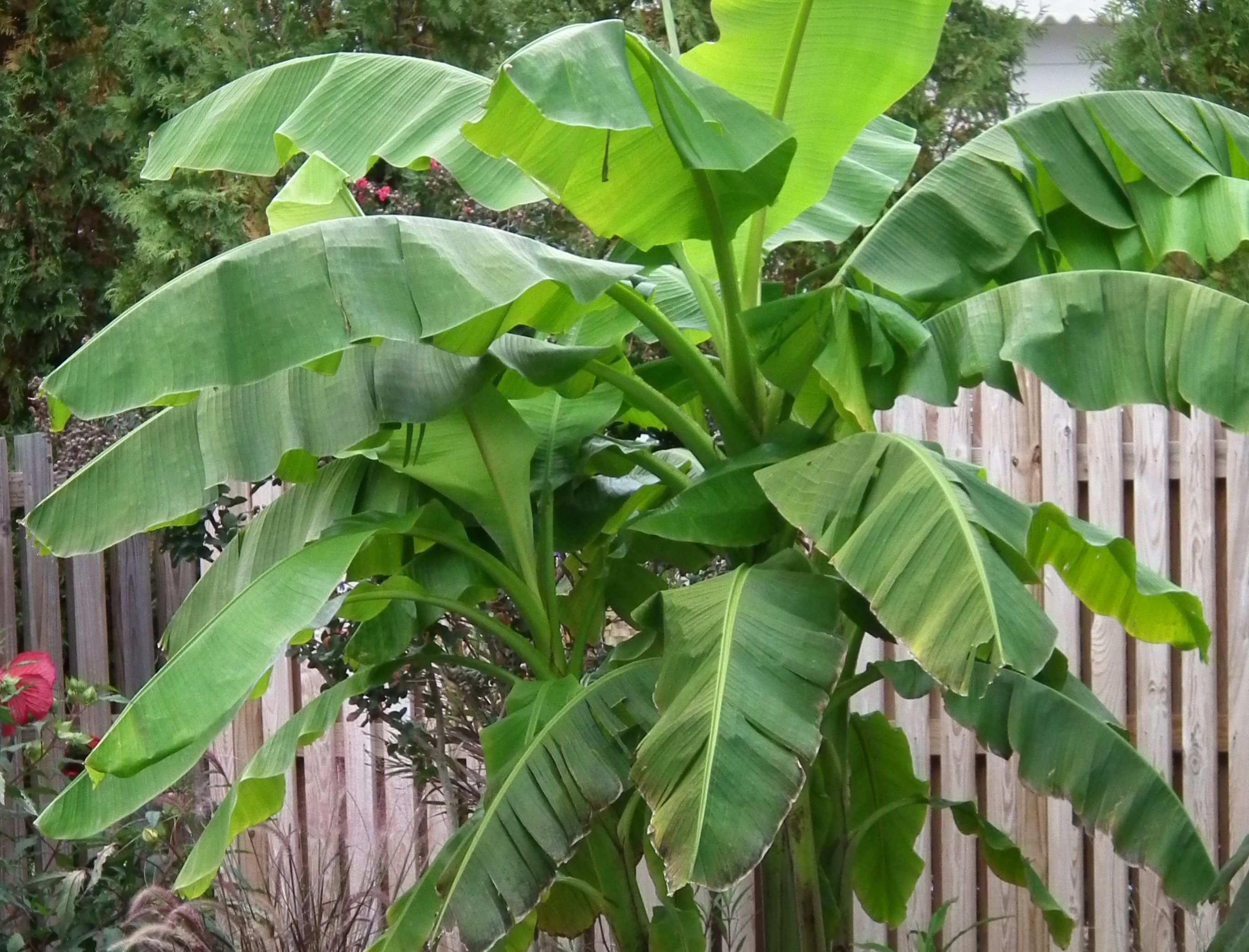Please note: Climates and environments vary across the country--what is ok in one area may be too aggressive or even invasive in another. To garden responsibly, you should check with your state and/or local Department of Natural Resources or Cooperative Extension Service for information on invasive plants in your area. You can also get information from the USDA National Invasive Plant Species Information Center. Thank you to Ginger from Wimberley, TX for telling us that Elephant Ears are invasive in Texas, and reminding us to help pass this important information along.
When designing a garden, a lot of thought is usually given to exposure, type of soil, maintenance requirements of various plants, and how the space will be structured. All very important, but to me the first question you should ask yourself is, “How do I want to feel when I’m in my garden?” Do you want to feel like everything is green, neat and tidy, so you feel the accomplishment of being able to move on to other things? Do you want to feel energized by bright blossoms and the activity of butterflies and birds? Do you need a serene space where you can feel at peace? How about a happy relaxed feeling like you’re on vacation on a tropical isle?
If that last one appeals to you, read on!
Even if you’re in a climate where this seems impossible, you can still approximate that island vacation atmosphere with the right plants and a little imagination. Combining large foliage, especially shiny or brightly colored leaves with climbing vines and under-plantings will create a jungle-like layered effect.
Oversized or less commonly seen flowers and unusual seed pods will take you to a land far away. Sunny shades of pottery will brighten the landscape. To top it off, the element of water, whether sparkling in a dramatic in-ground pool, bubbling from a decorative fountain, or shimmering in a birdbath, will transport you to a lush lagoon or a steamy jungle after a rain.
Here are some plant ideas to get your tropical staycation started:
Hardy Plants that Look Tropical
(Will overwinter up to zone 7B, at least, perhaps farther north than listed with protection)
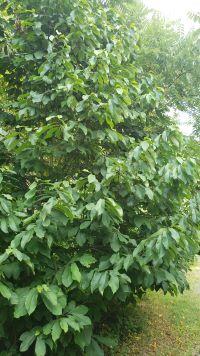
Paw Paw (Asimina triloba): Native to Kentucky, Tennessee and bordering states, and into parts of Michigan, Texas, Pennsylvania and Maryland. If you’ve hiked in woodlands in these states, you’ve probably walked right by one, and maybe even wondered what that weird thing was. More often see n as groups of young trees of less than 10 feet, mature trees can supposedly grow up to 45 feet, but ones that large are probably rare now. Paw paws produce the largest fruit native to North America, a fleshy greenish-yellow oval commonly 3 to 4 inches long and tasting of banana/mango/pineapple with a custardy texture. Sounds so good you want to grow some, right? Caveat: you need at least 2 trees of different genetic strains, which need to be pollinated by something attracted to rotting meat, and trees take 7 to 8 years to mature. Still, if you’ve got the time and space, it might be worth it. Paw paws have long oval green leaves clustered at end of stems, usually a rather open habit, and interesting maroon flowers in spring. If pollination occurs fruit ripens August to September. Being an understory tree in nature, they're best in part sun or shade. Note that the pictured specimen is growing on the edge of a woodland in an arboretum, so the exposed side having no competition is furnished all the way to the ground and is in general much fuller than one sees in the wild. These are becoming more available as interest in natives and food crops has spurred growers and breeders. Zones 5-9.
n as groups of young trees of less than 10 feet, mature trees can supposedly grow up to 45 feet, but ones that large are probably rare now. Paw paws produce the largest fruit native to North America, a fleshy greenish-yellow oval commonly 3 to 4 inches long and tasting of banana/mango/pineapple with a custardy texture. Sounds so good you want to grow some, right? Caveat: you need at least 2 trees of different genetic strains, which need to be pollinated by something attracted to rotting meat, and trees take 7 to 8 years to mature. Still, if you’ve got the time and space, it might be worth it. Paw paws have long oval green leaves clustered at end of stems, usually a rather open habit, and interesting maroon flowers in spring. If pollination occurs fruit ripens August to September. Being an understory tree in nature, they're best in part sun or shade. Note that the pictured specimen is growing on the edge of a woodland in an arboretum, so the exposed side having no competition is furnished all the way to the ground and is in general much fuller than one sees in the wild. These are becoming more available as interest in natives and food crops has spurred growers and breeders. Zones 5-9.
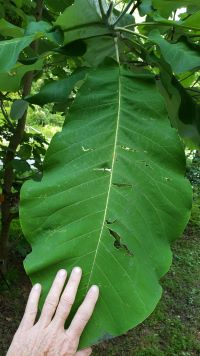
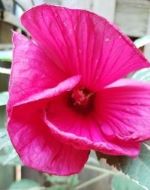
Perennial Hibiscus (H. moscheutos and H. coccineus hybrids): Everything about these screams tropical, from the large lobed foliage to the sizeable summer blooms. Much recent breeding has brought these down to sizes that better suit a small garden; they now range from bushy types like the 'Luna' series at 2.5 feet to the tall traditional 6 foot ‘Lord Baltimore.' They share big, maple-like leaves and 6 to 12 inch showy saucer shaped flowers with a delicate crepe paper look in reds, pinks, and white, usually with a red eye. Dark foliaged varieties add drama and depth; variegated types add to the fun. Does not tolerate much drought--these have been developed from native wetland plants. Slow to emerge in spring, so mark the spot to avoid damaging the crown. Full to part sun. Zones 4 to 9.
Bigleaf Magnolia (Magnolia macrophylla): Growing up I had one of these on the front lawn and wish I could find one now! Truly strange for a hardy native tree, it has huge green leaves reminiscent of banana--we used to pull them off and fan ourselves with them in the summertime. Large white flowers somewhat similar to Southern Magnolia and red seed cones follow, for 3 seasons of interest. Fall leaf color is yellow. Other similar native species include M. tripetala & M. umbellifera. If you visit the National Zoo in Washington, DC you'll find many of them in their plantings. Full to part sun. Zones 5-8.
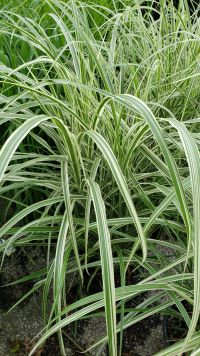
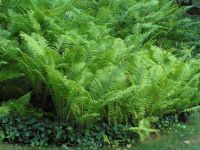
Large ferns & hosta: The bigger the better here. Think fluffy Ostrich ferns or Osmunda species (Cinnamon, Interrupted, or Royal ferns) up to 4-5' tall, and enormous hostas like 'Empress Wu' and 'Sum and Substance.' You want that Jurassic Park look. Zones 2 to 10, full sun with adequate moisture to full shade, depending on variety.
Miscanthus Cosmopolitan: Not your typical maiden grass, ‘Cosmopolitan’ has much wider leaf blades with creamy white variegation. Growing 6-8 feet high, it will form an arching clump 3-5 feet wide. Coppery inflorescences in late summer turn to feathery silver seed heads that persist well into winter. Zones 5-9, full to part sun.

Mahonia: Desperate shade gardeners are likely more familiar with this plant than others. It’s an odd-looking plant—like a tall nandina crossed with a holly. Substantial “fronds” of spiny, evergreen leaves layer up coarse woody stems to an average height of 4 to 6 feet. The real attraction is the fragrant yellow winter- blooming flower spikes followed by large berries of frosted blue. ‘Soft Caress’ is your best bet, a 3 to 4 foot size with soft, narrow leaves that puts one in mind of a short palm. Great texture and easy to grow, it will fit right in with a tropical theme. Named Mahonia cultivars you’ll find in nurseries will have varying sun/shade tolerance, and are usually hybrids of non-native species. The native species are more difficult to find unless you’re in the pacific northwest. Protect from midday sun. Zones 5 to 10, depending on species; 'Soft Caress' 7b-9.
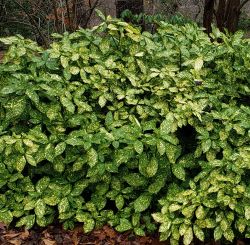
Aucuba japonica 'Variegata': A popular evergreen for shade, Aucuba is best known for its splashy yellow variegation (although there are solid green ones, too). Growing slowly to 6’ or more with a rounded bushy habit with large glossy pointed leaves. You’ll occasionally find other named cultivars with varying patterns of variegation--any shoots that revert to green should be removed. Female plants with pollinated flowers will develop attractive red berries. Part sun to full shade (keep direct hot sun off the leav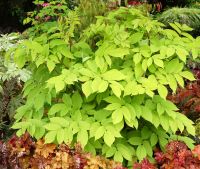 es or they will develop black burned spots). Zones 7-9.
es or they will develop black burned spots). Zones 7-9.
Aralia ‘Sun King’: Oh, how I love this plant, and evidently others agree, as it was named Perennial Plant of the Year for 2020. A fabulous plant to brighten up a semi-shady spot, with striking chartreuse foliage that lasts all season. Quickly creates a mound 3 to 4 feet high and just as wide or wider (in colder zones it may die back for winter and regrow anew each year). Plumes of white flowers bloom in summer, as if it needed anything else. Provides a stunning backdrop for shorter annuals or perennials. Deer don't seem fond of it. Part sun to shade. Zones 4-8.

Ligularia:Perennials noted for their love of moist soil and tolerance of shade. Big, rounded, somewhat wavy leaves topped with yellow daisy-shaped flowers in tall spikes or flat clusters in summer. But the foliage is always an attraction, whether green or bronze or purple, making clumps 2 to 4' wide and roughly 2' high. Ligularia 'The Rocket', has an impressive flower display, and 'Britt-Marie Crawford' boasts deep burgundy-chocolate foliage. One of the latest cultivars has the amusingly apt name 'Tractor Seat,' which is a reference to the size and shape of the leaves! Part sun to shade and moist to wet soil. Zones 4-8.

Sorbaria ‘Sem’ (False Spiraea): This is a relatively unknown but truly cool plant. Leafs out in spring with red, orange, pink, and chartreuse foliage that holds until mid-summer when green and bronze tones will dominate. In summer, large creamy-white astilbe-type fluffy plumes wave over the 3-5' foliage. May be a bit aggressive if it really likes its spot, as it does spread by root suckers. Since it’s hardy in zones 2 to 7, container culture will keep it in bounds and the roots should tolerate the cold (always line containers with bubble wrap to insulate roots from heat and cold). Some sources say it can tolerate heat to zone 9, but in zone 7 I’ve seen it suffer a bit during hot and humid summer spells. Cutting back will rejuvenate; partial shade in hot climates would be advisable. 'Mr. Mustard'™ is a smaller cultivar, about half the size of 'Sem.' Part to full sun. Zones 2-7.
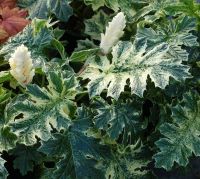
Bear’s Breeches(Acanthus): Several species are available with varying degrees of cold tolerance. All create a mound of enormous serrated edged leaves, above which phenomenally beautiful spires of white to pinkish-white blooms tower. Foliage anywhere from 2 ½ feet wide to 6 feet wide, and flower spikes 1 ½ to 6 feet high, depending on variety. My favorite is the green and white variegated 'Whitewater.' Full sun (for best flowering) to part shade. Zones 7 to 10.
Cold-Hardy Tropicals
(North of listed zones overwinter dormant in garage or basement that does not drop below freezing) Japanese Fiber Banana(Musa basjoo) Yes, Virginia, you can have a banana tree in....Virginia. And lots of other places up to zone 6 and even 5 if you mulch the roots well. North of zone 9 they will die back to the ground over winter, but can shoot up to 12 feet tall by summertime, with clumps increasing in girth each year. Nothing edible will be produced, but the tropical feeling you’ll get gazing at this
Japanese Fiber Banana(Musa basjoo) Yes, Virginia, you can have a banana tree in....Virginia. And lots of other places up to zone 6 and even 5 if you mulch the roots well. North of zone 9 they will die back to the ground over winter, but can shoot up to 12 feet tall by summertime, with clumps increasing in girth each year. Nothing edible will be produced, but the tropical feeling you’ll get gazing at this

from your lounge chair will more than make up for its lack of fruit. Full sun. Zones 5-10
Angel’s Trumpet(Brugmansia): So dramatic, so fragrant! Woody vine can be trained as a small (up to 12') tree. Trumpet shaped blooms 6 to even 20 inches long drip from the stems—a well-grown specimen in full bloom is a sight not to be forgotten. Usually white, yellow or pink. Full to part sun, fertilize regularly, and never prune below the forks in the trunk--they will not bloom below that. Zones 8-10.

Mexican Petunia(Ruellia britonniana ‘Purple Showers’): Upright grower to 4’ with long narrow dark green leaves and 1.5" glowing bluish-purple trumpet flowers (each lasting only a day) all summer. Must be encouraged to branch with early pruning or will grow literally straight up. Likes adequate moisture. In warmer zones may seed or spread aggressively, especially in moist to wet areas. Zones 7-10.

 Elephant Ear(Colocasia): Impressive foliage plant ranging from 2 feet to 6 feet, depending on variety. Grand arrowhead shaped leaves spring from underground bulbs on most varieties, so this one can easily be lifted and stored for next year if needed. Green types are the largest, but solid black and patterned black and green or green and yellow will add drama in a different fashion. Full sun is best. Up to zone 7, depending on variety.
Elephant Ear(Colocasia): Impressive foliage plant ranging from 2 feet to 6 feet, depending on variety. Grand arrowhead shaped leaves spring from underground bulbs on most varieties, so this one can easily be lifted and stored for next year if needed. Green types are the largest, but solid black and patterned black and green or green and yellow will add drama in a different fashion. Full sun is best. Up to zone 7, depending on variety.
If you'd like to grow some jungle style plants from seed, try these:
Ricinis communis, castor bean. This is the plant from which castor oil is made. Easy to germinate and grows up to 6 feet in a season. Beware if you have children or pets--the plant and especially the seeds are toxic.
Morning glory, moonflower, cardinal vine, and hyacinth bean vine are all stunning flowering annual vines you can grow in your "tropical" paradise. Just nick the hard seed coat and place the seeds between a couple layers of wet paper towelling for 24 hours, after which they should be sprouted. Plant in situ after frost or inside first in plantable pots, as they don't like their roots disturbed.
Squash plants are quick to grow into huge mounds of spectacular leaves that will cover quite a bit of space, and the golden yellow flowers are quite pretty. If you'd like grow some edibles in your tropical garden, this could work well. Just be on the lookout for squash vine borers, and be sure the plants get plenty of air circulation and avoid wetting leaves in evening to avoid powdery mildew.
Okra is another vegetable with that equatorial feel, resembling a perennial hibiscus, albeit with smaller, yellow blooms. Peppers of all types have fairly large green, glossy leaves and won't look out of place. Try "Fish Pepper," with its interesting variegated foliage, or several bell peppers that fruit in different colors including yellow, orange, and lilac.


